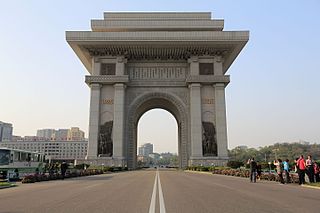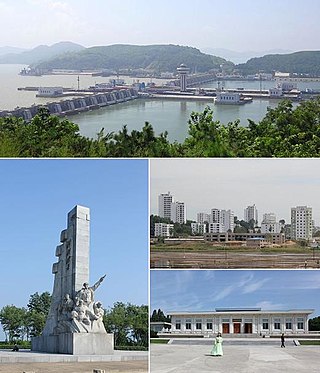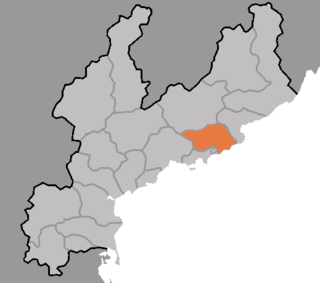Telecommunications in North Korea refers to the communication services available in North Korea. North Korea has not fully adopted mainstream Internet technology due to some restrictions on foreign interventions.

Pyongyang is the capital and largest city of the Democratic People's Republic of Korea (DPRK), commonly known as North Korea, where it is sometimes labeled as the "Capital of the Revolution". Pyongyang is located on the Taedong River about 109 km (68 mi) upstream from its mouth on the Yellow Sea. According to the 2008 population census, it has a population of 3,255,288. Pyongyang is a directly administered city with a status equal to that of the North Korean provinces.

North Hwanghae Province is a province of North Korea. The province was formed in 1954 when the former Hwanghae Province was split into North and South Hwanghae. The provincial capital is Sariwon. The province is bordered by Pyongyang and South Pyongan to the north, Kangwon to the east, Kaesong Industrial Region and South Korea's Gyeonggi Province to the south, and South Hwanghae southwest. In 2003, Kaesong Directly Governed City became part of North Hwanghae as Kaepung County. Later on in 2019, it was promoted as Special City. Thus, it was separated from North Hwanghae.

Nampo, also spelled Namp'o, is a city in North Korea which is the country's fourth-largest by population. The city is an important seaport in the country as it lies on the northern shore of the Taedong River, 15 km east of the river's mouth. Formerly known as Chinnamp'o, it was a provincial-level "Directly Governed City" ("Chikhalsi") from 1980 to 2004, and was designated a "Special City" in 2010. Nampo is approximately 50 km southwest of Pyongyang, at the mouth of the Taedong River. Since North Korean independence, the city has developed a wide range of industry and has seen significant recent redevelopment.

South Pyongan Province is a province of North Korea. The province was formed in 1896 from the southern half of the former Pyongan Province, remained a province of Korea until 1945, then became a province of North Korea. Its capital is Pyongsong.

South Hamgyong Province is a province of North Korea. The province was formed in 1896 from the southern half of the former Hamgyong Province, remained a province of Korea until 1945, then became a province of North Korea. Its capital is Hamhung.

Kim Il Sung University (Korean: 김일성종합대학) is a university in Taesong, Pyongyang, North Korea. Founded on 1 October 1946, it is the first institution of higher learning in North Korea since its foundation.
Taedong County is a kun (county) in South Pyongan province, North Korea.
Gangnam or Kangnam may refer to:

Songun is the "military-first" policy of North Korea, prioritizing the Korean People's Army in the affairs of state and allocation of resources. "Military-first" as a principle guides political and economic life in North Korea, with "military-first politics" dominating the political system; "a line of military-first economic construction" acting as an economic system; and "military-first ideology" serving as the guiding ideology.

Hŭich'ŏn is a city in the southern part of Chagang Province, North Korea. The population is 168,180.

Pukch'ŏng County is a county in eastern South Hamgyŏng province, North Korea.

Kangdong County, is one of Pyongyang's two suburban counties. In 1983 it was separated from South P'yongan Province and assumed direct governance by the Pyongyang City People's Committee. It is bordered by Sŏngch'ŏn-gun, South P'yongan in the north and east, Sŭngho-guyŏk from the south and the Taedong River from the west.
Chunghwa County is a county of North Hwanghae, formerly one of the four suburban counties of East Pyongyang, North Korea. It sits north of Hwangju-gun, North Hwanghae, east of Kangnam-gun, North Hwanghae, west of Sangwŏn-gun, North Hwanghae, and south of Ryŏkp'o-guyŏk, Pyongyang. It became part of Pyongyang in May 1963, when it separated from South P'yŏngan Province. Chunghwa-gun is the location of a few historic sights, such as the Chunghwa Hyanggyo, as well as a few KPA weapons units. In 2010, it was administratively reassigned from Pyongyang to North Hwanghae; foreign media attributed the change as an attempt to relieve shortages in Pyongyang's food distribution system.

Pyongyang station is the central railway station of P'yŏngyang, North Korea. It is located in Yŏkchŏn-dong, Chung-guyŏk.
Felix Abt is a Swiss business affairs specialist on North Korea and Vietnam.

North Korean cuisine is the traditional culinary practices and dishes of North Korea. Its foundations are laid by the agricultural and nomadic traditions in southern Manchuria and the Korean Peninsula. Some dishes are shared by the two Koreas; however, availability and quality of Northern cuisine is much more significantly affected by sociopolitical class divides.
This page is based on this
Wikipedia article Text is available under the
CC BY-SA 4.0 license; additional terms may apply.
Images, videos and audio are available under their respective licenses.











